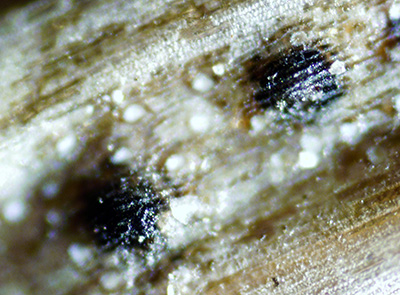Interior needles casting in Concolor fir
The fungal pathogen Phyllosticta spp. is causing the interior needles of Concolor fir to turn brown in landscapes and Christmas tree fields.

Phyllosticta has been documented on white and balsam firs and is associated with needle blight symptoms. A disease note published in 1997 documented it in Pennsylvania, and a more extensive paper published in 1989 documented it in Ontario (balsam fir) and Wisconsin (Concolor fir). More recently, this fungus is being detected on white fir with needlecast symptoms growing in Michigan.
Symptoms of this disease become noticeable during late summer and fall. Interior needles turn tan to brown usually in the lower portion of the tree, but remain attached. Initially, you may not see any fruiting bodies. Later, small, black fungal fruiting bodies, which contain spores, develop on the diseased needles. If you look closely, these fruiting bodies (pycnidia) are large enough to be seen with the naked eye. Spores are released from these structures and spread to nearby trees by rain.
Little information is available about factors that affect Phyllosticta development. As with other needlecast diseases we find in conifers, this disease appears most commonly on trees in areas with poor air movement or in areas where the foliage stays wet longer in the spring. These types of sites include larger trees, close spacing, shady areas, low spots or poor weed control.

Dark pycnidia obvious on needle. Photo by Bruce Watt, University of Maine, Bugwood.org.
Recommendations for managing Phyllosticta
If a small number of trees are infected, Michigan State University Extension suggests removing those trees to reduce the potential reservoirs of inoculum.
Make modifications to your site that allow needles to dry and reduce the chance of infection. To help manage these needlecast diseases, consider better air drainage, greater planting distance between trees and better site selection.
Applications of mancozeb or chlorothalonil during shoot elongation may provide effective control of this disease. Remember, these are protectant fungicides and the benefits of treatments may not be evident for at least one to two years. Also, the new growth of Concolor fir is very succulent. When high-pressure sprayers are used or conditions do not favor rapid drying of the spray on the needles, applications of fungicides can result in damage. Damage symptoms can appear as needle yellowing and the development of necrotic spots on the needles.



 Print
Print Email
Email


